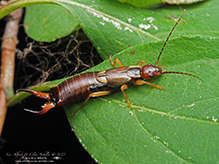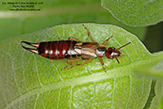Minnesota Earwigs

Order Dermaptera
Dermaptera is an order of insects that includes earwigs. It is a small order, with only about 1,800 species in about 200 genera of 11 families still in existence worldwide. There are 27 species in 12 genera of 6 families in North America north of Mexico. Only 4 species from 2 families are known to occur in Minnesota.
Dermaptera are characterized by:
- an elongated, flattened body;
- a head that is oriented horizontally with mouthparts pointing forward;
- chewing mouthparts;
- antennae segmented, thread-like, and no more than half as long as the body;
- compound eyes present in most species, reduced or lacking in some species;
- lack of simple eyes (ocelli);
- four wings in most species, rarely no wings;
- forewings (elytra) short, thickened, leathery, veinless, and meeting in a straight line down the back;
- hindwings membranous, semicircular, and folded beneath the forewings at rest;
- appendages at the end of the abdomen (cerci) well-developed, unsegmented, and forceps-like;
- ovipositor in females absent or reduced; and
- the last part of the leg (tarsus) with three segments.
Recent Additions

European earwig (Forficula auricularia) is native to Europe, western Asia, and North Africa. It was introduced into North America in 1907 or earlier and spread quickly, hitchhiking in vehicles and in shipments from other countries. It is now found across the continent and is the most abundant earwig in North America. Adults are omnivorous, feeding on live and dead small insects and on living and dead plant matter.
A common myth is that the name earwig refers to the insects crawling into the ears of sleeping human beings. In fact, it refers to the shape on the unfolded, semicircular hindwing, which vaguely resembles a human ear.
Earwigs are easily identified by the elongated body and long, forcep-like appendages at the end of the body. European earwig is distinguished by the brown coloration; antennae with 14 segments; and the second segment of the end part of each leg with a lobe at the end that is expanded both to the side and forward under the third segment.
Other Recent Additions
This list includes only earwigs that have been recorded in Minnesota, but not all of the earwigs found in Minnesota.
| Profile | Photo | Video | |||
|---|---|---|---|---|---|
lesser earwig (Labia minor) |
|||||
ring-legged earwig (Euborellia annulipes) |
|||||
spine-tailed earwig (Doru aculeatum) |
Doru aculeatum (spine-tailed earwig)
Euborellia annulipes (ring-legged earwig)
Forficula auricularia (European earwig)
Labia minor (lesser earwig)
No Species Page Yet?
If you do not see a linked page for a species in the list at left you can still upload a photo or video or report a sighting for that species. Click on one of the buttons below and type in the common name and/or scientific name of the species in your photo, video, or sighting. A new page will be created for that species featuring your contribution.
These buttons not working for you?
Simply email us at info@MinnesotaSeasons.com.




